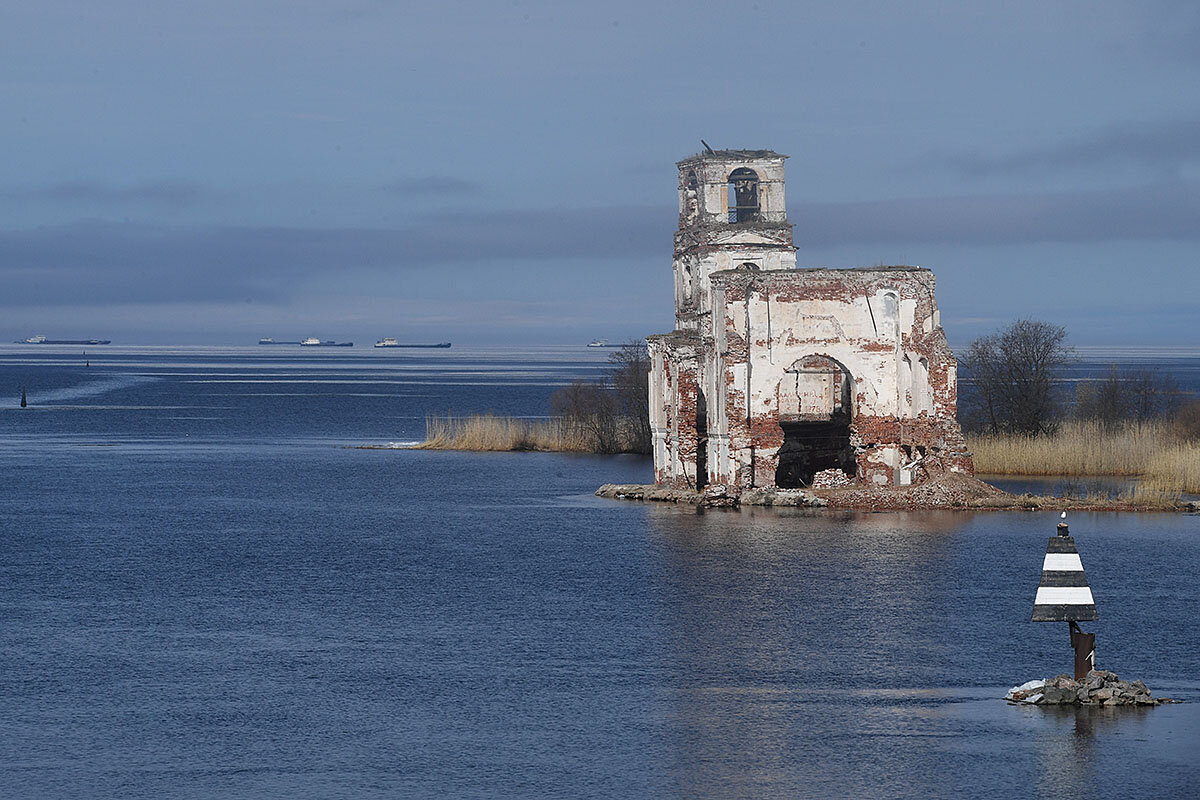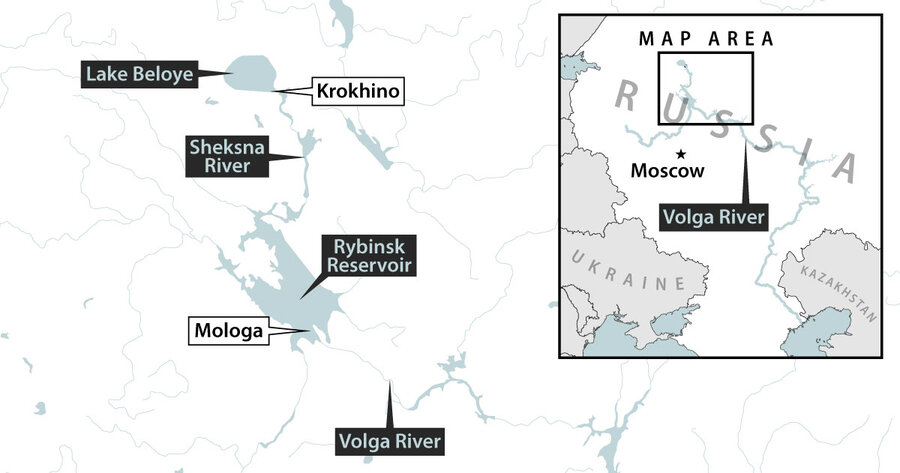Russia’s peasant history, once submerged, is brought back into the light
Loading...
| Moscow
Every summer, the immense Volga River system is heavily trafficked by steamers, tour boats, and recreation-seekers. But most who pass by the huge artificial lakes that dot the Volga and its tributaries are oblivious to what lies just a few feet below the waves.
The lakes cover the sunken ruins of hundreds of traditional villages, including scores of ancient churches, monasteries, and other irreplaceable gems of old Russian architecture.
Anor Tukaeva, a young engineer and urban studies expert at Moscow’s Higher School of Economics, is bringing that drowned history back into the light in a way that is rare in Russia.
Why We Wrote This
Russia’s peasant life was destroyed during the rise of the Soviet Union, literally covered over with water and dirt. But some, like Anor Tukaeva, are doing the hard work of bringing that history back into the light.
A dozen years ago, she was drawn by a view of the decaying, flooded hulk of the 18th-century Church of the Nativity, once the pride of the village of Krokhino, which now lies beneath the waters of Lake Beloye in northwestern Russia.
“When I tried to find out about it, what shocked me was that there was almost no information at all about those flooded territories,” says Ms. Tukaeva. She organized an expedition to the place, along with other interested people. “As we began to gather information about it, we realized this is a real historical vacuum. It was a trauma that affected many, many people and is not talked about at all.”
Finding the human stories
Vast Volga territories were submerged during the titanic transformation known as the “Soviet industrialization,” a forced modernization drive that began in the 1930s and, within a few decades, wrenched what had been a peasant society into the 20th century. It’s a story that Russian schoolchildren still learn in heroic, Promethean terms, a tale of overcoming backwardness and creating a modern, industrial superpower.
During those decades of industrialization, the once free-flowing Volga River was blocked by numerous hydroelectric dams, backing up waters over the low-lying farmlands that had been the cradle of modern Russia in order to create the voluminous water reservoirs and the electric power needed to fuel Soviet urbanization. The populations of those doomed territories, estimated to have been several hundred thousand people, were evacuated and scattered to the four winds, their stories seemingly lost forever.
Krokhino, an ancient town on the banks of the Sheksna River, a Volga tributary, was flooded in 1961. The Krokhino Cultural Heritage Revival Center, which Ms. Tukaeva helped to found, has organized over 50 expeditions to the area in the past 10 years. It began with efforts to shore up the collapsing church, but moved on to gathering photos and artifacts saved from the flooding, and searching for people who had lived in the lost village to recover their stories.
“We found that people were reluctant to speak about it at first,” she says. “They would say, ‘We don’t remember anything, we know nothing, we don’t want to talk about it.’ It was clear that the subject was still very painful, and they were suppressing their memories. Eventually we met a local inhabitant, a woman whose grandmother was from Krokhino, and she volunteered to help. She gradually got people to talk to her, to open up their family albums, and speak about the painful past. ...
“It’s amazing. We began by taking an interest in an architectural object, the half-submerged church, but it led us inexorably to the human stories. You just can’t do the first without moving on to the second.”
The center has since produced a video titled “Unflooded Stories,” with photos and film footage as well as the voices of surviving inhabitants of Krokhino. It has also prepared a full exhibition in cooperation with several local museums, though it has had to be postponed due to the coronavirus crisis. The exhibit, which has support from many quarters, including the Kremlin, is now slated for sometime in 2021.
“We are looking at just one little, tiny corner of a very big story,” Ms. Tukaeva says. “We need to join forces with people from all the regions that were flooded, look deep into the archives, if we have any hopes of putting together the full story. It’s a huge work for the future.”
The destruction of peasant life
Further downstream, lying beneath the waters of the Rybinsk Reservoir, is the historic Russian city of Mologa, which was submerged in 1937. In addition to the city, about 700 small villages, 50 churches, and several ancient monasteries were lost forever.
“We are accustomed to saying that the Volga River is Russia’s mother, but in fact we systematically destroyed it between the 1930s and the 1970s,” says Yevgeny Burdin, a historian at Ulyanovsk State Pedagogical Institute and expert on the flooded territories.
“Imagine eight hydroelectric dams, seven of them really big. Around 1.7 million hectares [about 4.5 million acres] of fertile land submerged. The Volga is a lowland river, so the flooded territories were huge, about the size of Slovenia,” he says. “We have not been able to compile accurate figures of the number of people displaced, but we think it was at least 600,000. They lost their ancestral homes, their farms, their wells, and the graves of their forebears.”
Critics say the purpose of Soviet leader Josef Stalin was not simply to rush industrial development, but also to destroy the traditional life and values of the Russian peasantry.
“Those new hydroelectric stations were symbols of the Soviet five-year plans and industrialization,” says Alexander Nikulin, director of the Center for Agrarian Studies at RANEPA, a state university. “But apart from the economic role, they also exerted an ideological influence on society. These huge projects were meant to change perceptions. They destroyed the traditional peasant way of life ... and divided families. While the older generations looked sadly upon these changes, the young were enthusiastic. The peasants made huge sacrifices, but the cities benefited from the changes. Villages, once the center of Russian life, found themselves on the sidelines of general progress.”
History was written by the winners, and now needs to be revised, says Ms. Tukaeva. “In Soviet years it was all about the triumph of man over nature, and the great advantages of channeling the rivers and building huge dams. Now we understand that cultural values and historical memory were lost during the forced migrations, and traditions destroyed. Thousands of archaeological monuments now lie at the bottom of reservoirs. ... So, our project is a long-term effort to fill in the other sides of the story.”
Mr. Burdin says that Ms. Tukaeva’s project is an inspiration he hopes many will follow in the future. “There are not many cases in Russia where one person’s initiative has produced such positive results,” he says. “One person’s example can show the way for others.”
Olga Podolskaya contributed to this report.








